The Vishera Review: AMD FX-8350, FX-8320, FX-6300 and FX-4300 Tested
by Anand Lal Shimpi on October 23, 2012 12:00 AM ESTProjected Performance: Can AMD Catch up with Intel?
I keep going back to this slide because it's incredibly relevant. It's the only indication we have from AMD of what its future roadmap will look like in terms of performance increases:
Each year AMD promised to increase performance of its high-end cores by roughly 10 - 15%. Astute observers will note that, at this rate, AMD will almost never catch up to Intel. AMD at the time was careful to point out that it's talking about 10 - 15% gains in core performance, and it could potentially see even larger increases in total chip performance by pulling other levers. Vishera is an example of AMD doing just that. The Piledriver cores by themselves don't increase performance tremendously, but they do give AMD a little more thermal headroom to work with thanks to some more efficient design decisions and better transistor choice. With Vishera, AMD took the additional power headroom and turned into a frequency advantage. The result is AMD's FX-8350 can operate in the same power envelope as the outgoing FX-8150, yet runs at an 11% higher base clock (turbo frequency remains the same). Through frequency and core level improvements, AMD was able to deliver a bit more than the 10 - 15% performance increased in promised.
If AMD is able to repeat these improvements again next year, I wondered whether or not it would get any closer to closing the gap with Intel - particularly when it came to single threaded performance. We already know from our Haswell investigations that Intel is expecting around a 5 - 15% increase in CPU performance from Haswell over Ivy Bridge. If we assume that Haswell delivers towards the 15% end of that spectrum, and if we assume that Steamroller delivers the same level of improvements that we saw from Piledriver/Vishera, we end up with some pretty interesting predictions for where things end up next year. I modeled the 2013 performance of high-end AMD and Intel platforms based on those two factors and plotted the curves in a few different benchmarks. For each generation I used the parts that AMD stacked up against one another (they are also fairly similarly priced). For 2011 I used the FX-8150 vs. Intel's Core i5 2500 and for 2012 I used the FX-8350 vs. Intel's Core i5 3570. The 2013 data is of course projected based on a 15% increase in performance from Haswell, and a repeat of the Vishera vs. Zambezi increase for AMD. This is mostly an interesting experiment so don't get too invested in the data.
We'll start with Cinebench, by far the most painful of the tests for AMD from a single-threaded performance perspective:
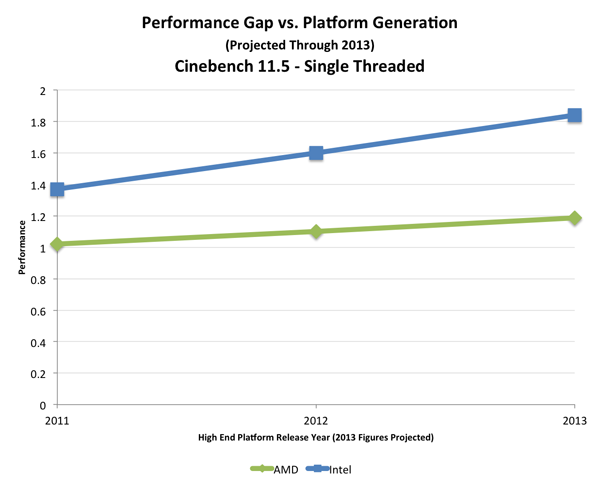
The Vishera gains here were decent but not enough to dramatically shrink the performance gap. Furthermore, Intel put a good amount of distance in place with Ivy Bridge and if it can continue that with Haswell I don't see much hope here.
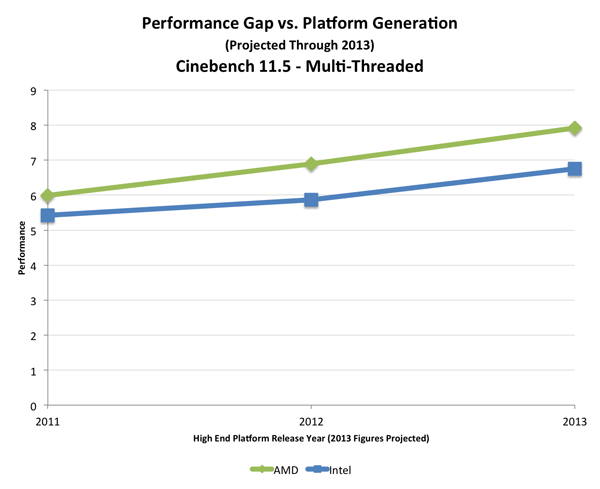
The multithreaded Cinebench results begin in AMD's favor and remain so even with our projected performance data.
Mozilla's Kraken benchmark is another example of single threaded performance gone awry for AMD.
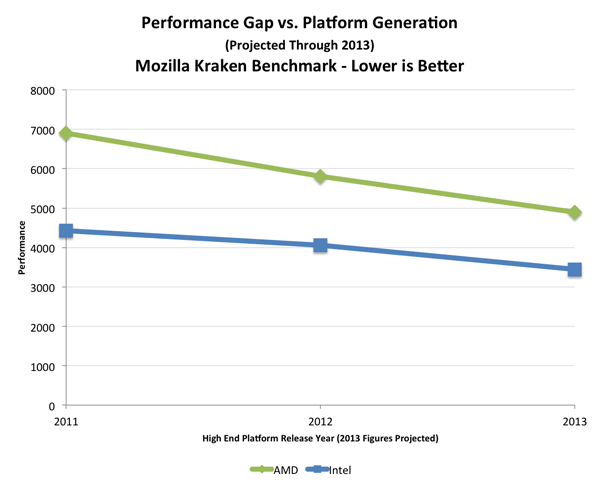
Thankfully, Vishera does close the gap by a decent amount and if AMD extends those gains it is on an intercept course with Intel. The bad news is, that intercept wouldn't be in 2013.
POV-Ray provides another point of view on single threaded performance, here the situation looks far less dire than under Cinebench:
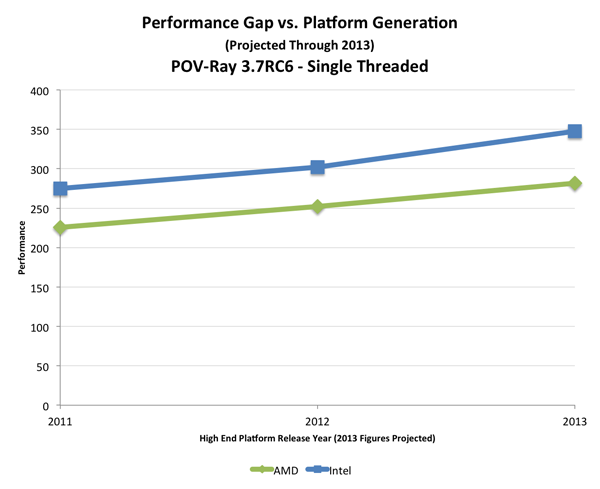
Unfortunately the curves remain fairly distinct.
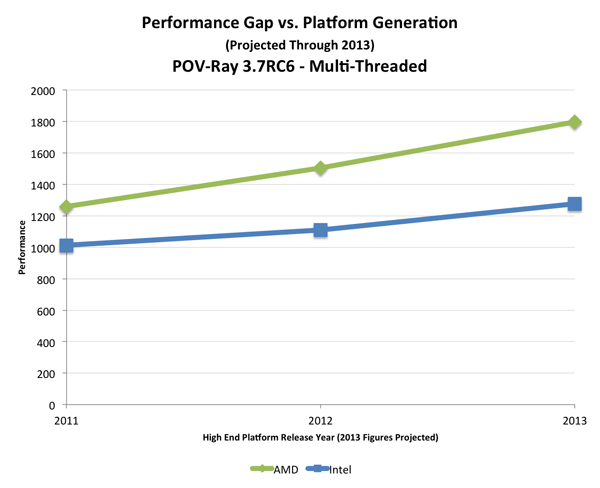
Once again, when we increase thread count we see AMD pull ahead.
SYSMark is a particularly telling benchmark as it is lightly threaded and does a good job of simulating all types of workloads:
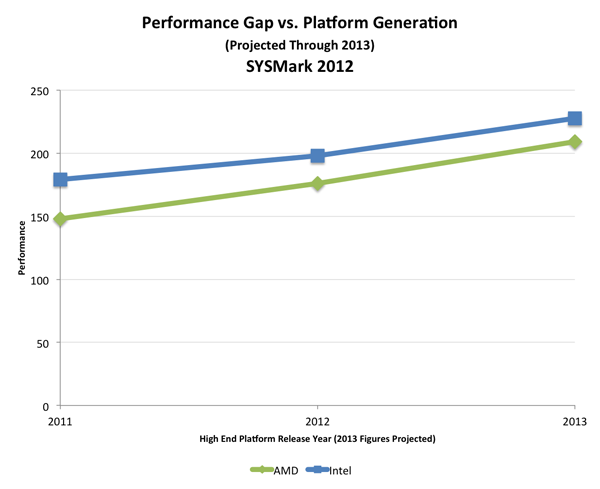
The result here is AMD closing in, albeit slowly, on Intel's performance advantage. I suspect this is quite possibly the best case scenario for AMD, it doesn't necessarily want to surpass Intel in performance but it wants to get close enough where pricing and other factors (e.g. GPU performance in its APU parts) can make a bigger difference.
Our Visual Studio 2012 test is a good combination of single threaded and multithreaded workloads in one:
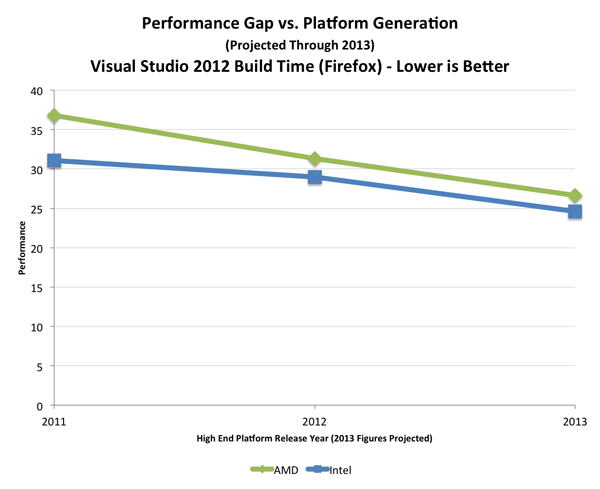
With Vishera, AMD did a lot to close the gap betwen itself and Intel. Another increase like this and we won't see AMD surpass Intel, but the two should remain fairly close.
These last two tests show us the other side of the coin. If both AMD and Intel continue on their present tracks, what will happen in a test where AMD already does well today?
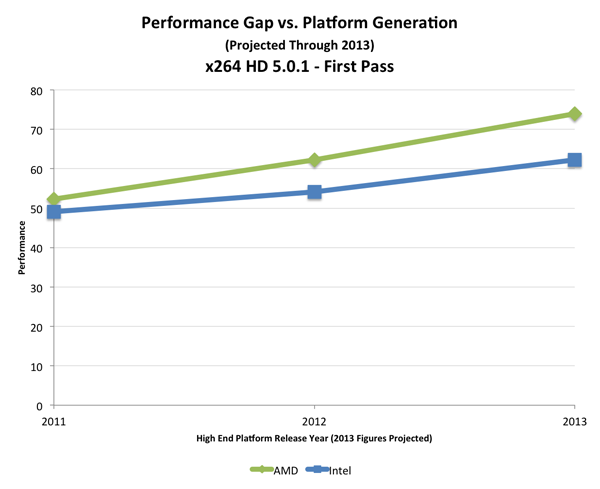
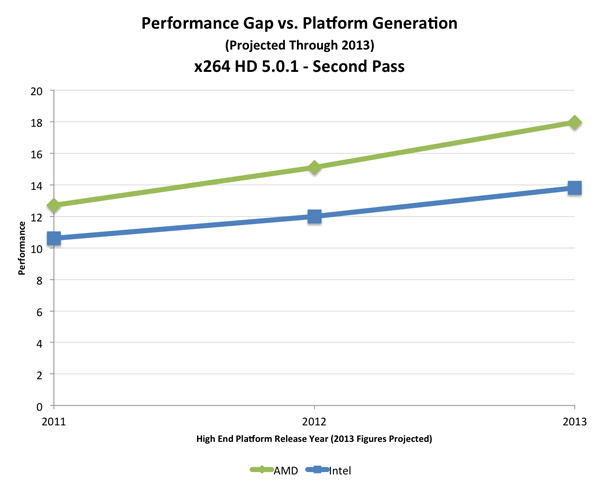
In areas where AMD holds a significant advantage, Haswell would need to deliver more than a 15% gain in performance at the same price point to catch up.
None of the results here are all that surprising. AMD remaining on its current course isn't enough to dramatically change its standings vs. Intel in another year. Vishera definitely cut into the performance delta, but the 2013 follow-up will have to do even more to really have an impact. Steamroller is far more focused on increasing IPC, however without a new process node it'll be difficult to demonstrate another gain in frequency like we see today with Vishera. I suspect the real chance for AMD to approach parity in many of these workloads will be with its 20nm architecture, perhaps based on Excavator in 2014.











250 Comments
View All Comments
CeriseCogburn - Tuesday, October 30, 2012 - link
Except we can probably agree amd will fail to meet their goal in most of these future cases and fail to meet it and be very late as well (cpu side after all and they suck at being on time) , so some sideways review with all the possible advantages in testing and text will need to be skewed toward the amd side ( and they will be) to be able to claim "amd met it's goal! "Let's face it, if amd meets some bare minimum "test" for "achieving that goal" in one single area, the review will claim "they accomplished it". Like the recent time amd released whatever it was a cpu or a vid card and they had a single or so instance of 5 or 10 PROMISED on the egg shelf the day of their declared release and we were told (yes here) "they did it !"
LOL
On the other side of the "perfectly legitimate 15% is an equal and fair equation of the future", we have Intel, that likely won't be late, and if so just barely, and has the cahunas and record to probably exceed their stated goals.
To be honest, the best I can do for amd is say I like their new cpu name " Steamroller !"
For some reason, and this is of course pure speculation, hopeful ESP, wimmin's intuition, or perhaps a desperate attempt to give them a break...but...
I think the name Steamroller indicates they will have a winner when that puppy comes out.
Yes, I think it's crazy as well, but what if I'm right ?
LOL
I might be absolutely correct.
ac2 - Monday, October 22, 2012 - link
I really like those graphs...Especially the Sysmark and Compile ones, which project Steamroller being ahead of Ivy Bridge, and of course clear wins for the multi-threaded ones.
I wish Anand had done a similar current->projection graph for power consumption as well, that would have been very useful.
* Fingers crossed *, I think (wish!) the next gen APUs, Steamroller + GCN + new process node will be a real winner for AMD assuming power envelop comes down to < 100W TDP across the board and delivery in 2013.
CeriseCogburn - Tuesday, October 30, 2012 - link
Isn't it interesting how when it comes to AMD, the fanboy will go to great lengths never before seen, never before done for any other product from any other entity ever, and I mean ever, and spend their time in pure speculation about the future, graph it out, get their hopes going, take a look at the futureville landscape - LOLIt's AMAZING.
Penti - Tuesday, October 23, 2012 - link
Just proves, as it would that there shouldn't be any AM3+ socket for AMD as there are no high-end processors and it doesn't even help for general computing, workstation and gaming performance that AM3+ has 8-core chips. If you want i3 performance and gaming why would you buy anything over FX4300? If you buy a chip like that why couldn't you and AMD just have gone with FM2 instead? Why not launch 8-core FM2 chips if you really want them in consumers hands? FM2 will get Steamroller, why not make sure it will be thriving as a platform instead of having two desktop platforms? I don't think AM3+ justifies it's existence, I don't really want it and it doesn't really bring anything. It just reminds me of the AM2/+ and AM3 Phenom II days and look dated. I understand that there is no hypertransport in the FM2 platform, but let workstation users just buy Opteron server chips. AMD still needs to up it's singlethreaded performance with about 50%.Mysteoa - Tuesday, October 23, 2012 - link
It is not so easy to make it for FM2. First they have to put the NB inside the CPU in the FX line, for it to work on FM2. That will require more space, power consummation and heat.Penti - Tuesday, October 23, 2012 - link
The NB has been inside the CPU since K8 (Athlon 64 / Opteron 2003). It's only a HT (or IO) to PCIe bridge and integrated GPU in Trinity, and they already have Piledriver in Trinity (only CPU for FM2) so what the hell are you talking about? It performs just the same and are more modern core for core. NB is just DRAM-controller and some registers. I see it more like LGA1155 is good enough for everything now days, so is FM2 despite not having 6 or 8 core CPUs, just having faster cpus is enough. You can bake, bind or layout faster processors for FM2 even adding the number of cores if you like. AM3+ chipset doesn't have PCIe 3.0 in the 990-series and don't seem to be getting it any time soon so why buy into that platform? Certainly isn't much more performing.Enthusiasts can use SR5670 and Opteron's. It's not like 990-series has USB3 support any way. Now, FM2 doesn't have PCIe 3 support either, but might support it in an upgrade. Which of course would require new CPU and new motherboards. On AM3+ it would require new motherboards with new chipset only. Don't think PCIe "2.1" is a hindrance though, and a new CPU would benefit greatly either way. It's just a list of things that adds on the "feels old" category.
ET - Tuesday, October 23, 2012 - link
So you want to block the upgrade path? If as you say the FX4300 is all that people need, they should go ahead and buy Trinity. I'm sure that AMD will also release Athlon CPU's for FM2 like they did with FM1 and Llano. But for people who want a higher end AMD CPU, perhaps to upgrade their old one, being able to use the same socket as the old one did is helpful. A stable platform is a good thing, and AM3+ motherboards have been on the market for a while. I just don't see the rationale behind junking it in favour of the socket-du-jour.Penti - Tuesday, October 23, 2012 - link
Naw, I would say just go with Socket C32 and Opteron derived products. It's an under utilized Socket any way. I don't want to give away choice, just have a more clean and sensible line for desktop. AM3+ just seems like an orphaned platform to put Bulldozer out there. So it has lost it's relevance. They should release higher-performing Trinity chips too is what I would argue for of course. Having four Sockets here doesn't make a lot of sense. Moving to C32 would enable enthusiast like board, cheaper workstation-boards with dual-socket too, i.e. two 8-core 4 module Piledriver chips. It has dual-channel DDR3 like the desktop platform's. Maybe even two higher clocked native 6-core variants would have been something. But they won't do it. Of course Intel doesn't need to counter with an enthusiast platform either.Mainstream platforms is where it's at. Having an upgrade path for two desktop platform's, different chipset's etc doesn't make a lot of sense right now.
SonicIce - Tuesday, October 23, 2012 - link
2nd paragraph: "Look beyond those specific applications however and Intel can pull away with a significantly lead."Dadofamunky - Tuesday, October 23, 2012 - link
With 16GB of RAM and eight threads, why aren't we seeing realistic VM-driven virtualization benchmarks? Honestly, this is a huge application area that remains ignored by AT in their core architecture reviews. Something I always look for and never find.